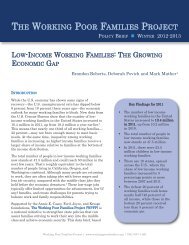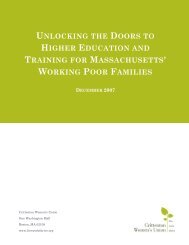alabama's working families and the broken promise of economic ...
alabama's working families and the broken promise of economic ...
alabama's working families and the broken promise of economic ...
- No tags were found...
You also want an ePaper? Increase the reach of your titles
YUMPU automatically turns print PDFs into web optimized ePapers that Google loves.
national st<strong>and</strong>ards, this is far less than that requiredto keep a family with two children out <strong>of</strong> poverty.Regressive tax systemThe combined local <strong>and</strong> state taxes for Alabama<strong>families</strong> in <strong>the</strong> lowest quintile amount to 10.6 percentas a share <strong>of</strong> annual household income. 72 At firstglance, this rate would appear to compare favorablywith o<strong>the</strong>r states, but a closer look reveals <strong>the</strong> unfairdistribution <strong>of</strong> tax obligations across <strong>the</strong> incomespectrum. Alabama is consistently ranked as havingone <strong>of</strong> <strong>the</strong> lowest total tax burdens, yet one<strong>of</strong> <strong>the</strong> most regressive tax systems in <strong>the</strong> country.While <strong>the</strong> poorest 20 percent <strong>of</strong> our neighbors payalmost 11 percent <strong>of</strong> <strong>the</strong>ir income in taxes, those at<strong>the</strong> top <strong>of</strong> <strong>the</strong> income scale pay only 3.8 percent <strong>of</strong><strong>the</strong>ir income in taxes. Alabama is also one <strong>of</strong> onlytwo states that fully tax food purchases <strong>and</strong> one <strong>of</strong> 31states without a state Earned Income Tax Credit.in <strong>the</strong> nation – <strong>the</strong> only state east <strong>of</strong> Colorado – thatrefused to make an investment <strong>of</strong> state revenues inpublic transportation programs. 73 The result is apublic transportation program that at best is inadequatefor user needs <strong>and</strong> at worst is non-existent.To access federal funds for public transportation,local governments or private entities must provide<strong>the</strong> entire amount <strong>of</strong> <strong>the</strong> required match. Because <strong>of</strong>constitutional restrictions on county <strong>and</strong> municipalauthority to generate revenue, <strong>the</strong> fixed-route systemsthat do operate in most urban areas <strong>of</strong>fer onlypartial geographical coverage <strong>and</strong> limited hours <strong>of</strong>service. Seventeen counties, primarily those withhigh rates <strong>of</strong> poverty, have been unable to raise <strong>the</strong>required match <strong>and</strong> <strong>the</strong>refore lack any transit systemthat could broaden residents’ access to employment,health care, commerce <strong>and</strong> entertainment.Until 2007, <strong>working</strong> Alabama <strong>families</strong> began payingincome taxes when earnings reached an annuallevel <strong>of</strong> $4,600 for a family <strong>of</strong> four. Changes madeto <strong>the</strong> state’s code in 2006 have increased thatthreshold to $12,600, still far below <strong>the</strong> federalpoverty level.TransportationOne <strong>of</strong> <strong>the</strong> most consistently identified barriers to<strong>economic</strong> advancement for low-income <strong>families</strong> is<strong>the</strong> lack <strong>of</strong> public transportation throughout ourstate. In 2005, Alabama was one <strong>of</strong> only four statesHow our income tax threshold comparesAlabama’s income tax threshold remains one <strong>of</strong> <strong>the</strong> three lowest in <strong>the</strong>country, even after <strong>the</strong> Legislature increased it in 2006 from $4,600 a yearto $12,600 a year for a family <strong>of</strong> four. But it hasn’t always been that way.When Alabama’s income tax rates were set in 1936, <strong>the</strong> state’s tax thresholdat <strong>the</strong> time — $3,600 — meant that only about 7,000 people in <strong>the</strong>entire state, or less than one-fourth <strong>of</strong> 1 percent <strong>of</strong> <strong>the</strong> population, madeenough to owe any taxes at all.Today, though, Alabama’s threshold lags behind those <strong>of</strong> its neighbors.Mississippi’s income tax kicks in for <strong>families</strong> <strong>of</strong> four at $19,600 a year,while Georgia begins to tax such <strong>families</strong> at $15,900 a year. (Florida <strong>and</strong>Tennessee do not assess income taxes.) O<strong>the</strong>r Sou<strong>the</strong>rn states also havehigher thresholds for <strong>families</strong> <strong>of</strong> four, including Louisiana ($16,900), NorthCarolina ($19,400) <strong>and</strong> South Carolina ($27,000).36 Bridging <strong>the</strong> Gap







